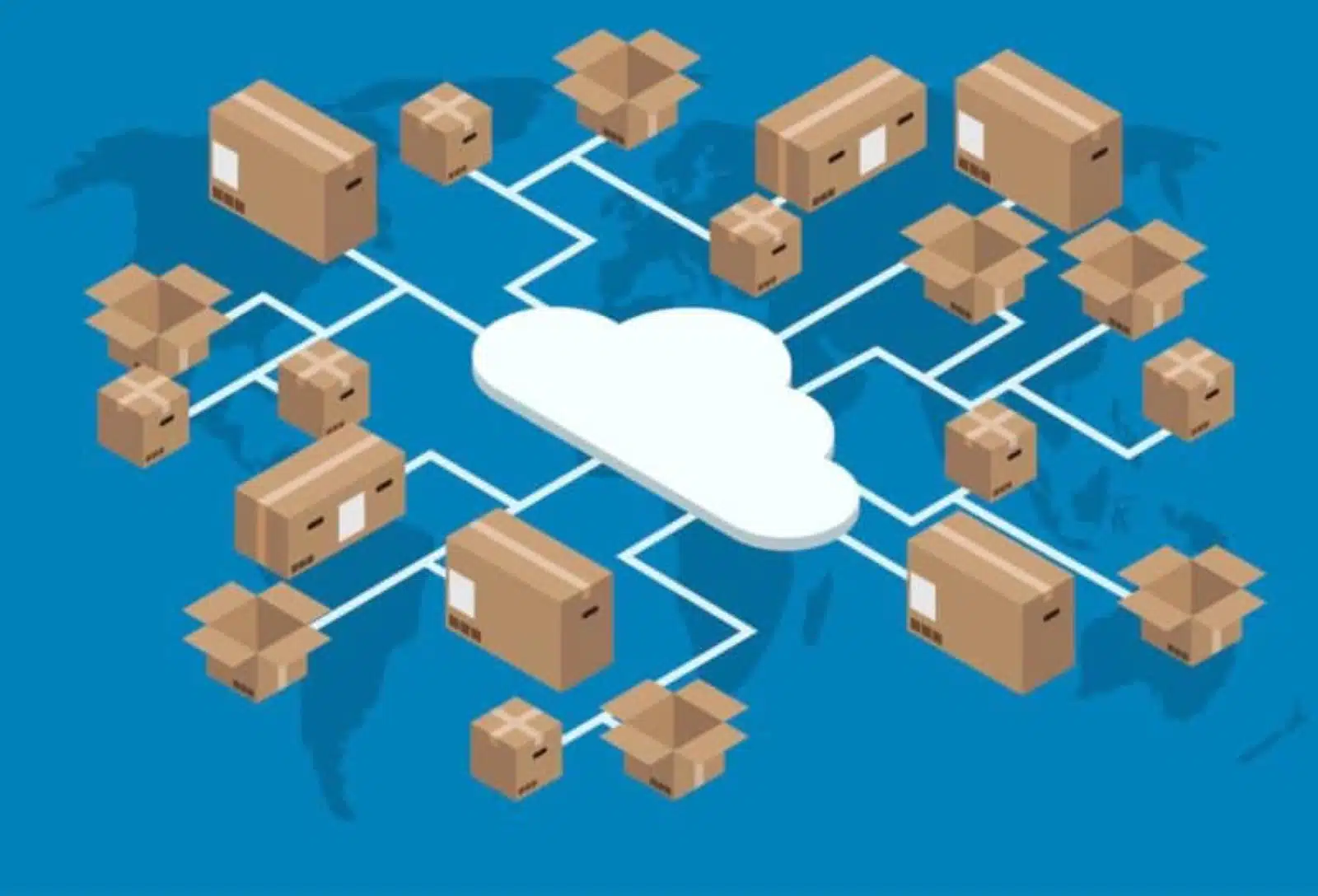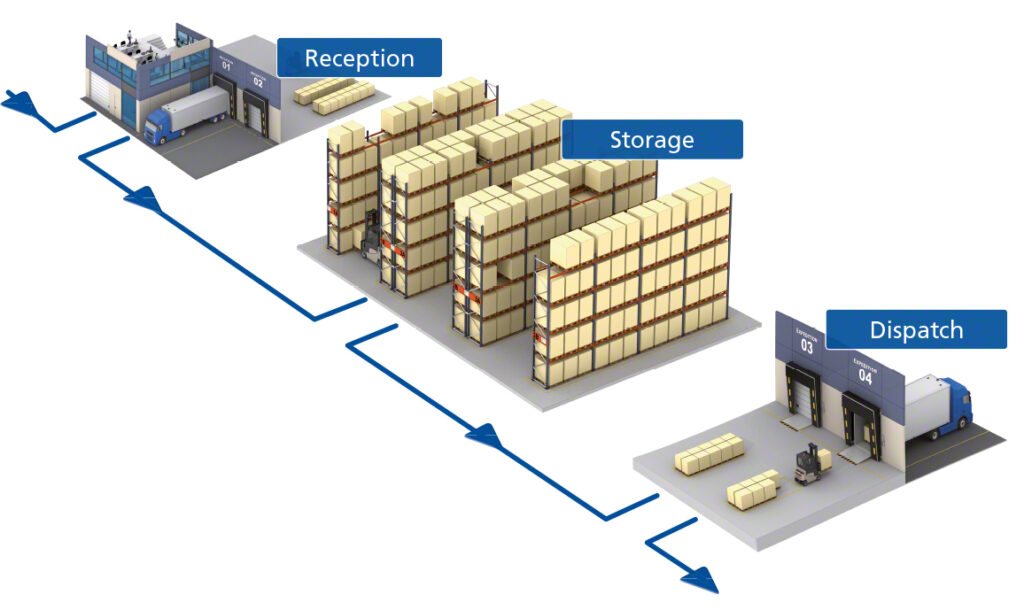Are you ready to transform your warehouse operations with the power of the cloud? Imagine seamless inventory management, real-time data access, and streamlined processes—all at your fingertips. This guide to Cloud WMS will show you how cloud-based warehouse management systems are revolutionizing the industry. We’ll explore what a Cloud WMS is, why it’s essential for modern businesses, and how it stands apart from traditional systems. Whether you’re looking to improve efficiency or stay ahead in a competitive market, this post has got you covered. Let’s dive into the future of warehouse management.
What is a Cloud WMS?
A Cloud Warehouse Management System (WMS) is a modern tool that helps businesses manage their warehouse operations more efficiently by using cloud technology. It offers several features that make inventory management, order processing, and shipment tracking easier than ever. This section will cover the core functionalities of a Cloud WMS and how it integrates with other cloud-based solutions.
Core Functionalities of a Cloud WMS
A Cloud WMS simplifies many aspects of warehouse management. Here are some of its key features:
- Real-Time Inventory Tracking: With real-time updates, you always know what you have in stock. This can help prevent overstocking or running out of important items.
- Order Management: Easily track customer orders from placement to delivery. This ensures that orders are fulfilled quickly and accurately.
- Shipment Tracking: Keep tabs on outgoing shipments and provide customers with real-time updates on their deliveries.
- Automation: Automate various tasks such as picking, packing, and shipping to save time and reduce errors.
- Reporting and Analytics: Generate detailed reports on inventory levels, order status, and overall warehouse performance. This data can help you make informed decisions.
Integration with Other Cloud-Based Solutions
One of the biggest advantages of a Cloud WMS is how well it integrates with other cloud-based tools. This connectivity helps create a seamless flow of information across different parts of your business. Here’s how:
- ERP Systems: A Cloud WMS can connect with Enterprise Resource Planning (ERP) systems to synchronize data on sales, finance, and supply chain operations. This helps keep everyone on the same page.
- CRM Software: Integrate with Customer Relationship Management (CRM) software to improve customer service by providing real-time updates on order status and inventory availability.
- E-commerce Platforms: If you run an online store, a Cloud WMS can sync with e-commerce platforms like Shopify or WooCommerce. This ensures that your online inventory reflects real-time stock levels.
- Third-Party Logistics (3PL) Providers: If you use external logistics services, a Cloud WMS can communicate directly with your 3PL providers to streamline shipping and receiving processes.
By connecting all these systems, a Cloud WMS provides a unified solution that saves time, reduces errors, and improves overall efficiency. This makes it an essential tool for modern businesses looking to stay competitive in today’s fast-paced market.
Benefits of Cloud-Based Warehouse Management Systems
Switching to a Cloud-Based Warehouse Management System (Cloud WMS) offers several advantages that can streamline your operations and boost efficiency. Let’s explore how a Cloud WMS can help your business.
Scalability and Flexibility
One of the most significant benefits of a Cloud WMS is its scalability and flexibility. Imagine your warehouse during peak seasons. The demands skyrocket, and you need more resources to manage the influx. With a Cloud WMS, you can easily scale your operations up or down based on your needs. Here’s how:
- Adaptable Storage: No need to worry about running out of space or having too much unused capacity. The system grows with you.
- Flexible Features: Add new functionalities as you expand. Whether it’s more advanced inventory tracking or additional user accounts, a Cloud WMS can accommodate.
- Remote Access: Manage your warehouse from anywhere. This is particularly beneficial if you have multiple locations or if you’re on the go.
Real-Time Data Access
Real-time data access is another crucial benefit of adopting a Cloud WMS. Quick and accurate information can be the difference between smooth operations and chaos. Why keep your fingers crossed when you can know exactly what’s happening at any given moment?
- Live Inventory Updates: Know immediately when stock levels change. This helps in maintaining optimal inventory levels and preventing stockouts or overstocking.
- Instant Analytics: Generate reports on the fly. Real-time data analytics help you make quick, informed decisions without waiting for end-of-day summaries.
- Enhanced Tracking: Track orders and shipments as they happen. This transparency helps in reducing errors and improving fulfillment times.
Cost Efficiency
Switching to a Cloud WMS is also a cost-effective solution. Traditional systems often require heavy infrastructure investment, but a Cloud WMS eliminates many of these costs.
- Lower Initial Investment: No need for expensive servers and hardware. All you need is an internet connection and compatible devices.
- Reduced Maintenance Costs: Since the provider handles software updates and security patches, you save on IT maintenance expenses.
- Pay-as-You-Go: Many Cloud WMS solutions offer subscription models. Pay for what you use, making it easier to manage your budget.
Enhanced Customer Satisfaction
Improving customer satisfaction is perhaps one of the most impactful benefits of a Cloud WMS. Happy customers lead to repeat business, and who doesn’t want that?
- Better Order Accuracy: Reduce errors in order picking and packing. When orders are right the first time, customers are more likely to return.
- Faster Delivery Times: Efficient processes mean quicker order fulfillment. Real-time tracking allows you to provide accurate delivery estimates, keeping customers informed and happy.
- Transparency: Offer your customers real-time updates on their orders. Transparency builds trust, and trust builds loyalty.
In conclusion, a Cloud WMS not only optimizes your warehouse operations but also boosts customer satisfaction, reduces costs, and provides flexibility and scalability. These benefits make it a must-have for any modern business looking to stay competitive in today’s market.
Key Features of Cloud WMS
A Cloud Warehouse Management System (Cloud WMS) is packed with a range of features designed to streamline your warehouse operations. From tracking inventory to managing orders and generating automated reports, a Cloud WMS offers robust tools that can significantly enhance efficiency. Let’s dive into the essential features that make a Cloud WMS indispensable.
Inventory Management
Inventory management is the backbone of any effective warehouse system. With a Cloud WMS, you get powerful capabilities that go beyond just tracking stock levels.
- Real-Time Tracking: Always know what you have in stock, down to the last item. This feature helps you avoid overstocking or shortages.
- Automated Reordering: Set predefined levels for automatic reordering to ensure you never run out of essential items.
- Batch and Expiry Management: Manage batches and expiration dates to minimize waste and ensure timely sales or usage.
- Multi-Location Support: Track inventory across multiple warehouse locations seamlessly, ensuring inventory data is unified and up-to-date.
Inventory management in a Cloud WMS is not just about knowing your stock levels; it’s about optimizing your entire inventory lifecycle.
Order Management
Order management in a Cloud WMS simplifies the entire order processing workflow, from order placement to fulfillment and returns.
- Order Processing: Accelerate the processing of customer orders with features like automated picking lists and barcode scanning.
- Fulfillment and Shipping: Integrate directly with shipping carriers to streamline the fulfillment process. Provide customers with real-time tracking of their orders.
- Returns Management: Efficiently handle returns. Track return reasons, restock items, and update inventory levels automatically.
- Multi-Channel Orders: Manage orders from various sales channels—be it your own e-commerce store, marketplaces, or physical retail locations—all in one system.
By optimizing order management, a Cloud WMS helps you deliver an exceptional customer experience, ensuring accuracy and speed in every order.
Automated Reporting
Automated reporting is a game-changer for decision-making. With a Cloud WMS, you gain access to insightful reports and analytics:
- Performance Analytics: Track key performance indicators (KPIs) like order fulfillment rates, stock turnover, and lead times.
- Inventory Reports: Generate detailed reports on inventory levels, stock movements, and aging stock to make data-driven decisions.
- Order Reports: Get insights into order trends, customer buying behaviors, and seasonal variations.
- Customizable Dashboards: Build custom dashboards to monitor specific metrics that matter most to your business.
Automated reporting in a Cloud WMS arms you with the data you need to make informed decisions, identify inefficiencies, and optimize performance.
In essence, a Cloud WMS not only improves your warehouse operations but also equips you with the tools to drive your business forward. By leveraging its key features—inventory management, order management, and automated reporting—you can transform your warehouse into a high-efficiency, data-driven operation.
How to Choose the Right Cloud WMS for Your Business
Choosing the right Cloud Warehouse Management System (Cloud WMS) for your business is a crucial decision. With the right system, you can streamline your operations, improve customer satisfaction, and boost your bottom line. Here’s a guide to help you make the best choice.
Vendor Reputation
Selecting a reputable vendor is essential. When it comes to Cloud WMS, the vendor’s reliability can make or break your experience.
- Track Record: Look for vendors with a proven history in the industry. How long have they been around? Do they have success stories or case studies to show?
- Customer Support: Reliable customer service is crucial. Imagine your system going down during a busy season. You’ll need quick, effective support to resolve issues. Make sure the vendor offers 24/7 support and has a good reputation for helping their clients.
- User Reviews: Check out user reviews and testimonials. What do other businesses say about their experience with the vendor? Look for reviews on independent websites to get unbiased opinions.
Customization Options
Every business is unique. Your Cloud WMS should be able to cater to your specific needs.
- Tailored Functionality: Does the system allow you to add or modify features based on your business requirements? For example, you might need specific inventory management tools or custom reporting features.
- User Roles: Can you create various user roles with different access levels? This is important to ensure that employees have access to the tools they need without compromising security.
- Scalability: As your business grows, your WMS should grow with you. Ensure the system is flexible enough to handle increased inventory, more users, and additional warehouse locations.
Integration Capabilities
Your Cloud WMS should seamlessly integrate with your existing systems to create an efficient workflow.
- ERP Integration: An effective Cloud WMS should integrate with your Enterprise Resource Planning (ERP) system. This will ensure data flows smoothly between your inventory, sales, finance, and supply chain departments.
- CRM Connectivity: Linking your WMS with Customer Relationship Management (CRM) software is crucial. It can enhance customer service by providing real-time updates on order status and stock availability.
- E-commerce Platforms: If you run an online store, integration with platforms like Shopify or WooCommerce is vital. This ensures your online inventory is always accurate, reducing the risk of overselling or stockouts.
- 3PL Providers: If you use third-party logistics, your WMS should connect directly with these providers. This integration will streamline your shipping and receiving processes, saving you time and reducing errors.
In summary, a reputable vendor, robust customization options, and strong integration capabilities are key factors in selecting the right Cloud WMS for your business. Make sure to consider these aspects carefully to find a solution that meets your needs and supports your growth.
Implementation and Best Practices
Implementing a Cloud Warehouse Management System (Cloud WMS) can revolutionize your warehouse operations. This section will guide you through the key steps for successful implementation and best practices to ensure smooth operation.
Planning and Preparation
Successful implementation begins with thorough planning and preparation. Start by understanding your unique needs and getting everyone on board.
- Needs Assessment: Identify your warehouse’s specific challenges and goals. Do you need better inventory tracking or improved order processing? Documenting these needs will help you choose the right features in your Cloud WMS.
- Stakeholder Engagement: Involve all relevant parties early in the process. This includes warehouse staff, IT team, and upper management. Engaging stakeholders ensures that everyone’s needs are addressed and builds buy-in for the new system.
- Vendor Selection: Choose a vendor that meets your needs and has a good track record. Look for vendors that offer robust customer support and customizable solutions.
- Budget Planning: Set a realistic budget that includes initial setup costs, training, and ongoing maintenance. Make sure you account for both direct and indirect costs.
Training and Support
Training and support are critical to ensure your team can effectively use the new Cloud WMS. Well-trained employees are more likely to embrace the changes and use the system to its full potential.
- Comprehensive Training Programs: Develop training programs that cover all aspects of the Cloud WMS. Include both theoretical and hands-on training sessions. Different roles may require different training modules.
- Ongoing Support: Ensure continuous support is available for troubleshooting and guidance. This includes having a dedicated support team from the vendor and an internal team well-versed in the system.
- Training Materials: Provide accessible training materials like manuals, video tutorials, and FAQs. These resources can help employees when they encounter issues or need to review procedures.
- Feedback Mechanism: Establish a feedback loop where employees can share their experiences and suggest improvements. Continually updating your training and support based on feedback can enhance system usage and efficiency.
Monitoring and Optimization
Implementation doesn’t stop once the Cloud WMS is live. Continuous monitoring and optimization are vital to maintain system efficiency and achieve long-term success.
- Performance Metrics: Set clear performance metrics to monitor the system’s effectiveness. Key indicators could include order accuracy, fulfillment times, and inventory turnover rates.
- Regular Audits: Conduct regular system audits to ensure the Cloud WMS is functioning as expected. These audits can help identify any issues early and allow for timely adjustments.
- Feedback and Adjustments: Use employee and customer feedback to make necessary adjustments. Sometimes minor tweaks can lead to significant improvements in efficiency and user satisfaction.
- System Updates: Stay updated with the latest software releases from your vendor. Regular updates can introduce new features, improve existing functionalities, and enhance security.
- Scalability Planning: Plan for future growth. This might include adding more users, expanding to new locations, or integrating additional features. A scalable Cloud WMS can grow with your business needs.
Implementing a Cloud WMS requires careful planning, comprehensive training, and ongoing optimization. By following these best practices, you can ensure a smooth transition and maximize the benefits of your new system.
Challenges and Solutions in Cloud WMS Adoption
Adopting a Cloud Warehouse Management System (WMS) can significantly enhance your warehouse operations. However, businesses often face challenges during this transition. Addressing these issues head-on can make the adoption smoother and more effective.
Data Security Concerns
Data security is a major concern when it comes to Cloud WMS. With sensitive information such as inventory data and customer details, safeguarding this information is crucial.
The Importance of Data Security
In the digital age, data breaches can have devastating effects on a business. Protecting sensitive information ensures that your customer trust remains intact and that your business meets regulatory requirements.
How to Mitigate Risks
- Encryption: Ensure that all data transmitted to and from the cloud is encrypted. This makes it much harder for unauthorized parties to access sensitive information.
- Access Control: Implement strict access controls to ensure that only authorized personnel can access critical data. Role-based access can be a useful method.
- Regular Audits: Conduct regular security audits to identify and fix vulnerabilities. Keep your system updated with the latest security patches.
- User Training: Educate your staff on best practices for data security, including recognizing phishing attempts and using strong, unique passwords.
Integration Issues
When adopting a Cloud WMS, integrating it with your other existing systems can be challenging. Seamless integration is key to having a unified and efficient operation.
Potential Integration Challenges
- Compatibility: Old systems might not be fully compatible with new cloud-based solutions.
- Data Transfer: Migrating data from existing systems to the new Cloud WMS can be complex and error-prone.
- Real-Time Syncing: Ensuring real-time data syncs smoothly between systems can be tricky.
How to Resolve Them
- API Connections: Utilize APIs (Application Programming Interfaces) for seamless data transfer. Many Cloud WMS platforms offer robust APIs for easier integration.
- Middleware Solutions: Consider middleware that can help bridge the gap between your old systems and the new Cloud WMS.
- Custom Integration Services: Work with IT professionals who specialize in systems integration to develop custom solutions that ensure compatibility and smooth data transfer.
- Testing and Validation: Before fully transitioning, rigorously test the integration with a focus on data syncing and real-time updates to ensure reliability.
Change Management
Implementing a Cloud WMS involves significant changes in how your warehouse operates. Effective change management strategies can ensure a smooth transition.
The Significance of Change Management
Without proper change management, employees may resist new processes, leading to inefficiencies and lower morale. Effective change management ensures everyone is on board and understands the benefits.
Strategies for Effective Change Management
- Clear Communication: Communicate the benefits of the Cloud WMS to all stakeholders and explain how it will positively impact their roles.
- Training Programs: Offer comprehensive training sessions for all users to help them understand and adapt to the new system.
- Support Systems: Set up support systems where employees can seek help and share feedback about the new WMS.
- Pilot Programs: Start with a pilot program to identify and fix issues before a full-scale rollout. This approach helps in fine-tuning the process.
- Continuous Improvement: Consider feedback and make continuous improvements to the system and processes. This adaptive approach ensures long-term success.
By addressing these challenges with proactive solutions, businesses can smoothly transition to a Cloud WMS, paving the way for more efficient and secure warehouse operations.
Conclusion
Cloud WMS systems are transforming warehouse management by making operations more efficient and data-driven. These systems offer real-time inventory tracking, order management, and seamless integration with other software, which simplifies processes and reduces errors.
Cloud WMS solutions stand out for their flexibility and scalability. Businesses can adjust their usage according to demand without major investments. Real-time data access enhances decision-making, while cost efficiency and lower maintenance costs add financial benefits.
Choosing the right system involves evaluating vendor reputation, customization options, and integration capabilities. Proper planning, training, and support are essential for a smooth transition.
Adopting a Cloud WMS can elevate warehouse operations, providing the tools needed for modern business success.




